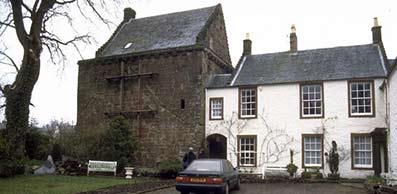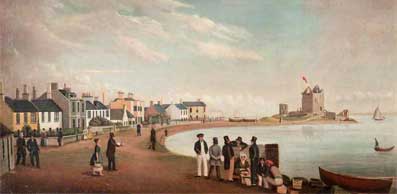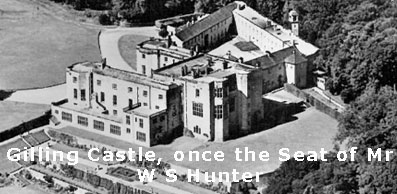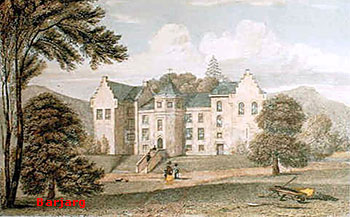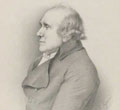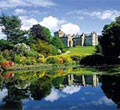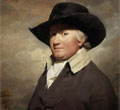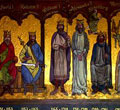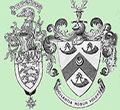History of Hunter
part three
He was succeeded by his son,
Kentigern, or Mungo Huntar of Huntarstoune or of that Ilk, who married Marion, daughter of James Hamilton of Torrance, county of Lanark, and with her was infeft in Easter Arneil on 1st August, 1537, during his father's life time.
He succeeded his father in 1546, as appears from an instrument of sasine of the 8th May of that year, and in the same year would seem to have been present with "Our Soverane Ladyis oist and army convenit at Dumbartane the xi. day of July, for asseging of the Castle thereof," as the Register of the Privy Seal contains a grant made to him of "all gudis moveable quhilk pertinit to William Finlay in Dairy, and Alexander Finlay, younger, and now pertening to our Soverane Lady, be resoune of Eschete throw thair tresonable remaining and abyding at hame fra our Soverane Ladyis oist and army," etc., etc., etc.
He "died at the faith and peace of Queen Mary under her standard at the battle of Pinkies-cleuth," 10th September, 1547, as appears by instruments of sasine of 8th November, 1548, and of 5th November, 1594, leaving two sons:
1 Robert, who succeeded him.
2 John, who married Janet Lindsay, as is set forth in the Commissary Records of Glasgow, where there are many entries in February and March, 1590, and on 25th March, 1591, regarding two actions at the instance of John Huntar, tenant of half the lands of Wester Dalquhorne, tutor of Huntarstoun, against John Spreul of Coldoun. He is also named in the Register of Decreets of the Lords of Session, 24th December, 1593, where there occurs a protestation for Robert, Master of Eglintoun, and Hew Montgomerie of Hesilhead, against "John Huntar, tutor of Huntarstoun, for not insisting in summons at the instance of Robert Huntar, son and apperand air to uncle Robert Huntar of Huntarstoun; the said John Huntar, tutor of Huntar, his father's brother, and Patrick Craufurd of Auchinames, his mother's brother, and nearest of kin to the said Robert Huntar, against the said Robert, Master of Eglintoun, and Hew Montgomerie, charging them to haif comperit before the lords,'' etc., etc., etc.
He is repeatedly named in the said Decreets in the action against him instituted by Robert Huntar of Huntarstoun, and his curators, and in the proceedings following thereupon, from 1594 to 1596. In the same Register of Decreets Marion Hamilton is named as his mother, and Robert Huntar is called his son.
In all these very voluminous proceedings, and in the numerous documents of the period, no mention is made of James Huntar, who married Janet Neil, the ancestor of the Abbotshill family, who, as Robertson affirms, ''is suposed to have been a younger son of Mungo Huntar of Huntarstoun, who, in 1547, was killed at the battle of Pinkie," and from whom, according to Burke, more than one family of the name are descended.
Marion Hamilton, widow of the deceased laird, was living in 1594, when she offers to prove before the Lords of Session that she has been in possession of the tower, fortalice and manor place of Hunterston for upwards of 48 years.
Robert Huntar of Huntarstoune or of that Ilk, (shown as 1 above) eldest son of the deceased Kentigern Huntar, was but an infant when he succeeded; he was served heir to his father in the lands of Campbelton on 2d October, 1548, "which had been in non-entry for one year in the hands of the Steward of Scotland."
In 1551 he held as a tenant the Isle of Lamlash, or Holy Isle, sold by his grandfather to the Earl of Arran, as is shewn by a precept of James Duke of Chatelherault, dated 24th April of that year; and he was infeft in certain lands within the lordship of Craufurdland in April 1551; and in the lands of Annanhill, "which had been twenty years and one term in non-entry," on 6th November, 1567. He held, also, certain lands in Knockintiber, sold to his father by Charles Mowat of Busbie, 24th July, 1571; and a rent of twenty merks yearly out of the lands of Kilcasche, sold by John Blair of that Ilk, 20th November, 1569.
He was one of those Ayrshire gentlemen who subscribed the Principal Band in defence of the reformed religion on 4th September, 1562.
On the 29th November, 1578, he obtained a Crown Charter from James VI. of Southcames, now the new town of Milport, with adjoining Red Farlane Rocks in the island of Great Cumbrae, which his ancestors probably held as rentallers, or Crown tenants.
He married Margaret, daughter of Thomas Craufurd of Auchinames, by Mareon, daughter of Sir John Montgomerie of Hessilhead, great grandson of Alexander, first Lord Montgomerie, and he died in 1580. (His widow married John Stewart, burgess of Glasgow, and they were both living on 6th July, 1597, as appears by decreet of the Court of Session.) Robert Huntar had by his wife, Margaret Craufurd, two sons and three daughters, viz. :
1. Robert, who succeeded him.
2. Francis, who died young.
3. Jean, married, first, Rev. Robert Cunninghame, minister of Barnwell, to whom she had two daughters:
Jean, who married Patrick Hunter, and of whom afterwards.
Catherine, married Robert Cunninghame of Auchinharvie, and died prior to the year 1613.
and her second marriage, before the year 1608, Rev. Alexander Scrymgeour, minister at Irvine, who died prior to May, 1617, as appears in a confirmation of that date in Commissary Records of Glasgow. She was living 30th June, 1624, as appears by a disposition of that date in Hunterston charter chest.
4. Katherine, married, first, Hugh Garven of Irvine, who died 29th June, 1607; and second, to the above-named Robert Cunninghame of Auchinharvie, on May 4, 1616, on which day her brother, the Laird, executed a precept infefting her and her son, Ninian Garven, in the lands of Hielies.
5. Marion, married Robert Peibles, one of the Baillies of Irvine, descended from a family of considerable respectability, and possessed of the estate of Broomlands, subsequently acquired by George, second son of Hugh Montgomerie of Stane. He died on 16th September, 1605, as appears by his testament, in which " He nominat Mareoun Huntar, his spouse, his onlie executrix, and .... recomendis his wyf and barnes and thair effairis to the rycht honorabill personnes following, to fortiffie and assist thame in all thair actiounes and causes, and to saif and preserve thame fra the injurie of sic as wald do thame wrang, viz. : Robert Huntar of Huntarstoun ; Hew Montgomerie of Aikenheid ; Johne Peblis of Brumlandis ;
Johne Peblis of Knokgerhill ; and Mr Allexander Scrymgeour, minister at Irvine."
He was succeeded by his eldest son,
Robert Huntar of Huntarston or of that Ilk, who was not then of age, and who was placed under charge of his uncle John, as tutor at law, as above stated, his curators being Robert, Master of Eglintoun, Hugh Montgomerie of Braidstane, John Stewart, Sheriff of Bute, Thomas Nevin, younger of Monkredding, John Craufurd of Craufurdland, and Robert Fergushill of that Ilk, styled "his kinsman" in a deed of 4th May, 1616.
He married Margaret, daughter of Patrick Peibles of Broomlands, by Marioun, daughter of John Montgomerie of Hessilhead, a cadet of the Eglintoun family, by Margaret, daughter of John Fraser of Knock.
Conjunctly with his wife, he received a Royal charter of South Cames in Bute, 20th July, 1580; and on 5th April, 1609, a royal charter of Arneil- Huntar, "with tower, fortalice, manor place, gardens, and their pertinents," and of Campbelton, Annanhill-Huntar, and South Cames.
In 1609 a somewhat serious difference arose between the Laird of Hunterston and Sir William Stewart, Captain of Dumbarton Castle, regarding the falcons on the Red Farlane Rocks in the great Cumbrae.
A rare breed of these much-prized birds frequented that part of the Red Farlane known as the " Hawk's Nest; " and as this head-land stands on the lands of South Cames, which belonged to Hunterston, the Laird asserted his right to the falcons that bred upon them; but the Governor of Dumbarton Castle disputed this right, and, as representative of the King, claimed them as royal birds, and interdicted the Laird from meddling with them; upon which the latter forthwith took the law and the falcons into his own hands, as is duly recorded in the Privy Council Minutes of 2d February, 1609, in which it is stated that Sir William Stewart, Captain of Dumbarton Castle, complains "that Robert Huntar of Huntarstoun, and Thomas Boyd, Provost of Irvine, had gone to the Isle of Comra, with convocation of the leidges, and tane away all the hawks thereon." The Lords of Secret Council declare, " that all the hawks quhilk bred on ye said isle properly belong to the King, and ocht to be for the cumand of his Majeste, and that the Captane of Dumbartane Castle intromit therewith yeirlie, and deliver the same to his Majeste, and discharges the said Robert Huntar and all vtheris from meddling therewith."
Having no issue, the Laird of Huntarstoun settled his estate on the husband of his niece, Jean Cuninghame, above mentioned, as appears from an instrument of resignation executed by him on the 27th September, 1611, in favour of " Patrick Hunter, son lawful to William Hunter in Beneberrie Yairds, and the heirs of his body procreat between him and Jean Cuninghame, his spouse, dochtor lawful to Jean Huntar, sister german to the said Robert Huntar," reserving only a life-rent for his wife, Margaret Peibles and himself, which destination was confirmed by charter James VI., dated 27th September, 1611.
On the 4th May, 1616, he alienated the lands of Annanhill Hunter to his kinsman, Robert Ferguson or Fergushill, of that Ilk. The charter still exists, endorsed in the handwriting of the last Laird of Fergushill, " given back to Huntarstoun qu : he bought back the land to be cancelled."
The " Hunterstoun " referred to being Patrick Hunter.
He died in the said month of May, 1616, as shewn by his testament, "faithfully made and given by Patrick Hunter, now of Hunterston."
His widow, " Margaret Peibles, Lady Huntarstoun," survived him. She is mentioned in the testament of John Tempiltoun in Hilhouse (one of the Hunterston farms), in the parish of Kilbride, May, 1617, as a "creditor of ferme the said yeir 1617."
The deceased Laird was succeeded by Patrick Hunter, who was the son of the above mentioned William Hunter, by his wife Mareoun Hamilton, as appears by "testament, etc. vmqle Mareoun Hamiltoun in Hunterstoun, qua deceist in the moneth of May, 1616 zeirs, ffaythfullie maid and gevin up be Williame Hunter in Binberrie Zairds, hir spous, in name and behalf of Patrick Hunter, onlie lauchful sone to the defunct, executour datiue," etc. " James Hunter, sonne to Robert Hunter in Air, George Hunter in Hunter (stoun), Alexander Hunter in Hunterstoun, and Johne Hunter, burgess of Air," are mentioned in this testament.
He was born about a.d. 1591, and consequently could not have been of age when he married Jean Cunninghame, the heiress of Hunterston, about 1611.
He was served heir on the 11th July, 1616, in a Precept of that date by Charles, as Prince and Stewart of Scotland.
In June, 1630, he sold the lands of South Cames in Cumbrae to Sir Robert Montgomerie, elder of Skelmorlie. After this sale, the small islets called " The Allans," which formed a part and pertinent of this estate, continued to be possessed by the proprietors of Hunterston, although they are not specially reserved or mentioned in the conveyance to the purchaser. In 1634 he repurchased the lands of Annanhill from Robert Ferguson or Fergushill of that Ilk, and obtained a Crown charter from Charles I. on 25th January of that year.
His name occurs, among those of other gentlemen, in the Committee of War for Ayrshire, in the troublous times of 1647.
In 1662 we find the Laird of Hunterston fined £600 by one of Middleton's arbitrary acts.
He was present at the nuptials of his grandson, Patrick Hunter, with Marion Cunninghame, on 15th August, 1662, signed the marriage contract, and lived to see their children.
He died about 1665, aged 74, as appears by two epitaphs, one in Latin and the other in English, which are still preserved. The former is of considerable literary merit, and contains a clever play on the name Venator or Hunter: the latter is quaint and curious, but is too long to allow of aught but a few statistical extracts. The poet laments that: -
" Loe heir a cedare lys that seventie-four years stood
By Neptune's strande, spreading his blossoms fair,
Feiding and sheltering Hunters in the Wood,
Bravely out-darringe the cold winter's air.
Hath chased to death this worthie man,
Yea, in dispyt your long; continued chase,
He saw his children's children's children's face.
But can we cease to sighe when we doe mynd
How thou repaired our Huntar's ancient towne,
How Judgement, Witt, and Righteousness combined
To make thy grate old age a glorious crowne"
Patrick Hunter left issue: -
1. Robert entered Glasgow College on 27th July, 1627 who succeeded.
2. Henry, a minister of the Church of Scotland. He was Laureated in the University of Glasgow in 1650, entered the ministry, and settled at Dromore in Ireland. He was ejected by Jeremy Taylor, Bishop of Down, in 1661, along with sixty co-presbyters, for non-conformity. He visited Scotland occasionally during the persecutions which followed, but kept up a connection with his flock at Dromore, to whom he was ultimately restored in 1670; and he died amongst them unmarried in November, 1673. He was an accomplished scholar, and was doubtless the author of the Latin epitaph above alluded to.
3. Francis, from whom it is supposed that the Hunters of Long Calderwood were descended, and of which family was the eminent physician, Dr William. Hunter, who was the son of John Hunter of Long Calderwood, by Agnes Paul, his wife, daughter of Mr Paul, sometime Treasurer of Glasgow, who was born 23d May, 1718, at Easter Kilbride, in Lanarkshire. He died at London, 30th March, 1783 ; and he bequeathed his valuable museum to the University of Glasgow, at which College he had been educated.
His brother, the celebrated John Hunter, who will ever hold a foremost place in the history of science as a surgeon, an anatomist, and a philosopher, was born on the 13th February, 1728. He married Anne Home, daughter of Mr Home, surgeon, of Burgoyne's Regiment of Light Horse, a sister of Sir Everard Home, and the authoress of the words of all the canzonets of Haydn. He died at London, where he had long practised with unrivalled reputation, 16th October, 1793.
Their sister, Dorothy, married to Dr James Baillie, professor of divinity in the University of Glasgow, was mother of Dr Baillie, physician to the King, and of Joanna Baillie, the authoress of several works of great merit.
The great-grandson of Archibald, younger brother of John Hunter of Long Calderwood, is William Hunter, M.D., of Woodbank, Largs, late of the Coldstream Guards, who was gazetted to the regiment on the 10th February, 1814, and retired after haying been surgeon-major for the last seven years, on the 2nd September, 1845. He served with that distinguished corps in the Peninsula, and was present at the sortie by the French from the citadel of Bayonne, where the Coldstreams lost 8 officers and nearly 200 men in killed and wounded. He was present at the battles of Quatre Bras and Waterloo, at the capture of Paris, and remained in France with the army of occupation until Nov. 1818, when the regiment returned to England. He married Helen, daughter of the Rev. David Wilkie, and sister of the celebrated David Wilkie, R.A.
Patrick Hunter of Hunterston had likewise by his wife, Jean Cuninghame, two daughters, viz.
1 ....... married about 1640, to Alexander Cuninghame of Carlung, a cadet of the Glencairn family.
2. Jean, married, about 1653, to David Kennedy of Balmaclanachan and Craig.
He was succeeded by his eldest son......

